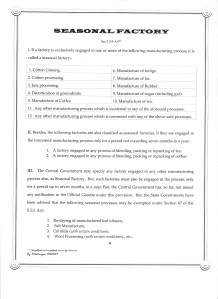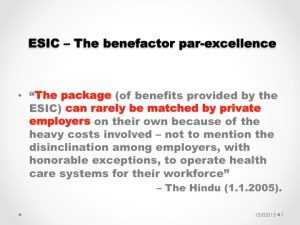The ESI Act was enacted only with the objective of providing a variety of benefits to the working population. The provisions for inspection mentioned in the statute are, therefore, not contradictory to this objective but only to ensure and further that objective. The perception that the inspection procedure in the ESI Act is intended to harass the employers is not correct and has been orchestrated by vested interests with ulterior motive. One may recall that when the Government of the UK had brought in many labour reforms through the Factories Act 1802 (also called the “Health and Morals of Apprentices Act”, which regulated factory conditions, especially in regard to child workers in cotton and woollen mills), provisions were made to impose fine between £2 to £25 on the factory owners for violation of law. But, the Act did not yield the desired results, as it failed to include any provision for supervision to make sure the law was being followed. It was in the year 1833 that the concept of inspection was born and the sufferings of the workmen at the hands of greedy employers came to be preventable.

But, in India, the importance of inspection is diluted again and again for the past seven years in the ESIC. Adding to the misery of the workforce is the amendments in other labour laws and dilution in their implementation, All these have practically converted the entire labour force of India into Slave Labour. The latest dilution in inspection of the factories and establishments, in the guise of mechanisation and centralisation, results in the sufferings of the honest and innocent workmen as the employers have come to know that they would not, in practice, face any penal action for non-payment of contribution on all items of ‘wages’ in respect of all ‘employees’. The drastic reduction in revenue that flows in, on its own, through Sec. 39 & 40 of the Act is a clear indicator of this fact. India is virtually sliding backwards to the pre-1833 era of the UK.
It is a fact that large number of employers try to avoid paying contribution in respect of “all” (as mandated by Sec. 38) the persons employed by them for wages. They resort to various methods of manipulations of their records to conceal the “employment of persons’ and “payment of wages”.
Such concealed employment can be detected only through proper inspection including Ledger Verification in a thorough manner. A simple visit by the Inspector or his going around the factory cannot help detecting such cases.
You get only what you inspect.
Proper and in-depth inspections alone can ensure that all the coverable employees have been covered without being left out, and that contributions are paid on their behalf on all items of wages. Simply expecting that the employers would pay contribution on all items on which it is payable, just because there is a law to that effect would not work.”You don’t get what you expect. You get only what you inspect”. This is what the IAS officers are taught too.
Besides, when contribution is not paid on all items of wages, the benefits payable becomes only be a pittance and would not help sustenance of the family of the insured persons during the periods of sickness, maternity, etc.,
Sec. 45 (1) and (2) are there in the ESI Act is, therefore, intended to safeguard the benefit provisions and they are there in the Statute to protect the interest of the employees. (For more on the need for inspections: https://flourishingesic.info/2012/11/22/esic-inspection-procedure-and-its-impact-on-society/)
Voucher Verification
The most essential component of inspection is “voucher verification”. The inspectors (SSOs) of the ESIC and the officers who conduct test inspections are specially trained on this aspect, so that they can detect concealed employment and omitted wages. “The books of accounts would not be of much use without the vouchers, records, papers, etc., on the basis of which such books have been prepared” (Circular dated 27.06.1961 of the Department of Company Affairs).
Any expenditure without proper voucher is to be frowned upon. Instances are numerous when wages were hidden in a voucher pertaining to different kind of expenditure. Likewise, many employees were paid through a voucher created in the name of a single person. The inspector, therefore, goes through vouchers with adequate care and caution.
But, in the peculiar circumstances of our society, there are many instances where genuine expenditure on certain other items are booked in the ledger, without there being any supporting voucher. Such expenditure does not, actually, represent the wages paid by the employer to his employees. What should the inspecting authorities do, then? Can they treat all such voucher-less expenditure, automatically, as wages and claim contribution from the employer? Do they have discretion to ignore such vouchers in toto? Where, then, is the line that differentiates genuine or arbitrary exercise of such power of discretion?
A case of huge expenditure without vouchers
There was a hotel of repute in a prime locality in a city. A minimum of five thousand customers visit the hotel every day to take food. The inspecting authority of the ESIC was pouring through the ledger and vouchers. He found that a large chunk of money accounted for as expenditure in the ledger under a head of account without any voucher for any day. The amount was too huge to ignore. The head of the account was ‘Purchase of Vegetables’. An inspecting authority is not there just to report the expenditure to the Regional Office and believe that he has done his work. He must, being the man on the spot, make genuine efforts to collect all the relevant documents and evidences and arrive at his findings and report the details to the Regional Office for decision. What did he do, in this case?
The employer explained that as a caterer he had to buy vegetables from various vendors, both retail and wholesale, in the market early in the morning at about 3.00 am, every day, depending upon the price and quality. No vegetable vendor would give receipts for the transactions. Not every vegetable vendor is running his trade in an organised form. So, obtaining vouchers from vegetable vendors is simply impossible, practically, he said. And, what he said was true, the inspecting authority knew.
He, therefore, verified the expenditure incurred by the hotelier for purchase of Rice, Wheat, Rava and Maida. He prepared a chart comparing the total expenditure incurred for purchase of these items with the expenditure incurred for the purchase of vegetables. He went through the ledgers once again to ensure that the expenditure for purchase of vegetables had not been booked under any other head of account. He arrived at the fact the expenditure shown under the head ‘Purchase of Vegetables’ had been incurred only for purchase of vegetables although it was not supported by vouchers. He reported all these facts along with his findings that the expenditure on purchase of vegetables was not wages, although the expenditure every year on that count was very huge. His report was examined in depth at the Regional Office and the Regional Director accepted his findings. (Even if the Regional Director had differed, he cannot blame the inspecting authority for his findings. Because, the inspecting authority had given not only his findings / opinion but also all the relevant facts on which he based his opinion and had left the decision to the Regional Office. If the Inspecting authority had reported only the quantum of expenditure as per the ledger figure, he would have been guilty of non-exercise of the power vested in him and transferring his work to the Regional Office. If he had reported only his opinion that said item of expenditure was not wages, he would have made his position vulnerable, in the event of the higher authority taking a different stand. In this case, the inspecting authority had given a speaking and convincing report, the contents of which proved that the inspection had, really, been purposeful.)
Another case of huge but sporadic expenditure
There was an inspector of the ESIC, who was known among employers of the area for his sincerity, honesty and pleasing manners. (It is appropriate to mention in the context the fact that the employers do always collect information about the nature and disposition of the inspecting authorities of various departments, whenever a new incumbent assumes charge in their area). This inspector of the ESIC was conducting regular inspection of the factory of an employer who was employing around 40 employees in his factory, situated in a semi-urban area with a sufficiently large lawn and backyard with many trees all around. The inspecting authority, while verifying the ledger, came across a head of account titled ‘Dog-feed Expenses’. He thought that the entries of expenditure under that head of account showed the cost of food and, possibly, other maintenance charges to rear the dogs in the premises of the factory. But, he found some peculiarity in the pattern of expenditure. The expenditure had not been incurred every month in a uniform pattern. There was some expenditure in a month. There was no expenditure at all next month. There was huge expenditure in the subsequent month. The inspector was puzzled.
He, therefore, asked for the vouchers. But, the clerk of the employer did not produce them. The inspector insisted on the production of those vouchers. Yet, no voucher was produced and no explanation offered. The inspector, therefore, completed the inspection otherwise and, then, wanted to meet the employer. It was around 3.00 pm, when he was ushered in to meet the employer. The inspector conveyed his findings to him. The employer was listening and was agreeing with him about the defects pointed out by the inspector.
The inspector, then, asked the employer about the expenditure shown as ‘Dog-feed expenses’. The employer said that it was not wages. But, he expressed his inability to produce vouchers for that expenditure. He was also not able to explain how and why the expenditure was sporadic and not uniform every month, if the amount was spent to feed the dogs.
The employer maintained silence. The inspector said that, because of the non-production of vouchers in spite of specific demand, all the items of expenditure under that head of account, could be presumed to be wages and contribution claimed on those omitted wages. The employer thought over for some time and said that he would pay contribution on those omitted wages. He was, still, not ready to explain what that expenditure was. The inspector said that he might have to pay interest and damages too on that expenditure. The employer said that he knew that.
The inspector recorded these facts and issued Visit Note and wound up the inspection. He did not receive the ‘cover’ repeatedly attempted to be given to him by the clerk of the employer, during the course of the day and at the time of leaving the factory. The employer was impressed as he had already heard of the reputation of that inspector. He, therefore, volunteered to walk along with the inspector to the front gate to see him off. The inspector could not see any dog anywhere in the factory precincts and asked the employer about it. The majestic-looking turbaned employer put his hand on the shoulders of the inspector, hugged him and replied, softly, with a smile, that the expenditure booked under that head of account was not the money spent to feed the real dogs. It represented the amount demanded by and paid to the officers of various departments as bribe and to the political parties as donations. That was the reason for the sporadicity of the expenditure, he said. Both of them burst into laughter.
The employer, then, asked the inspector to keep the information confidential and said that he was revealing it only to him, in appreciation of the commitment of the inspector to remain honest by choice.
If only all the employers follow suit ……














